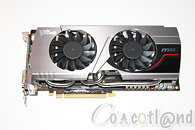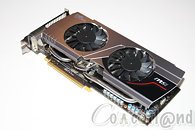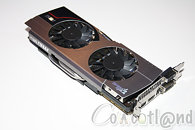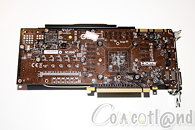- Joined
- Oct 9, 2007
- Messages
- 47,611 (7.45/day)
- Location
- Dublin, Ireland
| System Name | RBMK-1000 |
|---|---|
| Processor | AMD Ryzen 7 5700G |
| Motherboard | Gigabyte B550 AORUS Elite V2 |
| Cooling | DeepCool Gammax L240 V2 |
| Memory | 2x 16GB DDR4-3200 |
| Video Card(s) | Galax RTX 4070 Ti EX |
| Storage | Samsung 990 1TB |
| Display(s) | BenQ 1440p 60 Hz 27-inch |
| Case | Corsair Carbide 100R |
| Audio Device(s) | ASUS SupremeFX S1220A |
| Power Supply | Cooler Master MWE Gold 650W |
| Mouse | ASUS ROG Strix Impact |
| Keyboard | Gamdias Hermes E2 |
| Software | Windows 11 Pro |
Here are the first pictures of MSI's non-reference design GeForce GTX 680 Twin Frozr III graphics card (model: N680GTX Twin Frozr 2GD5/OC). The card features an NVIDIA reference design PCB, augmented with MSI's signature Twin Frozr III cooling solution, which has been used on several high-end GPUs till date, including the Radeon HD 7900 series, and previous-generation GeForce GTX 500 series.
The cooler appears to be tailored to fit the length of the PCB perfectly. It uses a large aluminum fin array, to which heat is fed by five 8 mm-thick nickel-plated copper heat pipes, ventilated by two 70 mm fans. The card comes with out of the box clock speeds of 1058 MHz (core base), 1124 MHz (core boost), and 1502 MHz (6.00 GHz GDDR5 effective) memory, so while the memory clock remains untouched, the core (base/boost) have been upped from 1006/1058 MHz (reference). The card uses 6+6 pin PCIe power inputs, and has display output layout identical to that of the reference design.




View at TechPowerUp Main Site
The cooler appears to be tailored to fit the length of the PCB perfectly. It uses a large aluminum fin array, to which heat is fed by five 8 mm-thick nickel-plated copper heat pipes, ventilated by two 70 mm fans. The card comes with out of the box clock speeds of 1058 MHz (core base), 1124 MHz (core boost), and 1502 MHz (6.00 GHz GDDR5 effective) memory, so while the memory clock remains untouched, the core (base/boost) have been upped from 1006/1058 MHz (reference). The card uses 6+6 pin PCIe power inputs, and has display output layout identical to that of the reference design.




View at TechPowerUp Main Site









